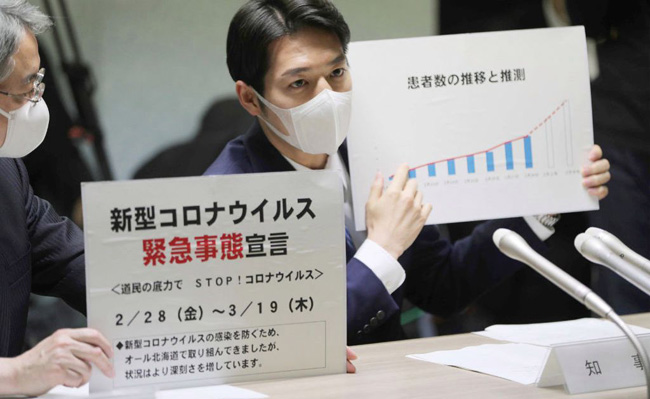
Hokkaido Governor Naomichi Suzuki declares a state of emergency during a meeting on the new COVID-19 coronavirus in Hokkaido prefecture on Feb. 28, 2020
Hokkaido … News Time
The Japanese island of Hokkaido is teaching the world a lesson about the epidemic of code 19 caused by the new novel coronavirus. The island in northern Japan responded immediately to the outbreak with a three-week lockdown, but the governor lifted the ban, after which a second wave of disease hit it hard. Only 26 days after the end of the lockdown did the lockdown resume on the island. Dr. Kiyoshi Nagase, chairman of the Hokkaido Medical Association, which co-operates with the local government response, says: “Now they wish something different had happened. I’m sorry now; we didn’t end the lockdown first.” Should have the Hokkaido experience is now a lesson for leaders around the world who are considering softening the lockdown. Experts say ending the lockdown too soon under pressure from businesses could exacerbate the epidemic.
Kazuto Suzuki, deputy head of the Department of International Politics at the University of Hokkaido, said Hokkaido proves, for example, that the opening of states by individual governors in the United States is very dangerous. Of course you can’t stop interstate traffic, but you need to control, we now know that even if we control the first wave, there is no need to calm down. Hokkaido has a population of 5.3 million and was the first part of Japan where the epidemic began and prompted an immediate response. More than 12,000 cases have been confirmed in Japan so far, but the number has doubled in the past two weeks, which is worrying.
Early action:
The annual Snow Festival was held in Hokkaido on January 31, attended by more than 2 million people, most of them Chinese tourists who were celebrating the Lunar New Year holidays. During the festival, a local doctor saw the first coronavirus patient, a woman from Wuhan, after which several Chinese tourists fell ill and the virus soon spread to locals. One month after the first case, on February 28, the number of cases had reached 66 and the governor declared a state of emergency. Schools were closed and a number of restaurants and businesses were banned, which the public banned and locked themselves in their homes.
Wrong sense of security:
The crisis seemed to end in mid-March, with no new cases, but complaints from businesses. Businesses began to oppose the state emergency, and on March 18, the governor eased sanctions. Authorities at the time did not know much about the virus and did not know how fast it spread, according to Dr. Kiyoshi Nagase, who provided assistance to the government response. Due to the lack of scientific data, doctors based their recommendations on the idea that coronavirus spreads like influenza, and now Dr. Nagasi regrets why he did so.
The second wave was bigger than the first:
According to Dr. Nagasi, the lifting of the ban was announced before the three-day holiday and citizens took to the streets and gathered in restaurants to celebrate the end of several weeks of incarceration, possibly triggering a second wave of the virus. With the easing of restrictions in Hokkaido, people in other parts of Japan have stopped considering the disease more dangerous and have resumed their daily activities. This intensified the second wave and a record 18 cases were reported in one day 3 weeks after the end of the lockdown. On April 14, a second lockdown was imposed and the second wave reported 279 cases, 80 percent more than the first wave, up from 495 by Wednesday this week. This time the business community also warmly welcomed the tough lockdown. Dr. Kiyoshi Nagase said the island has learned a hard lesson and until a vaccine or medicine is introduced, everyone will have to prove their personal responsibility and possibly be safe until next year. This type of lockdown cannot be undone.



